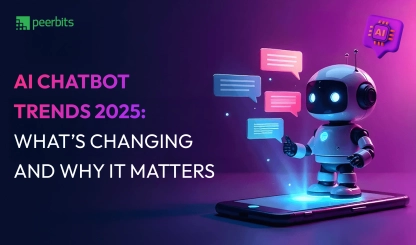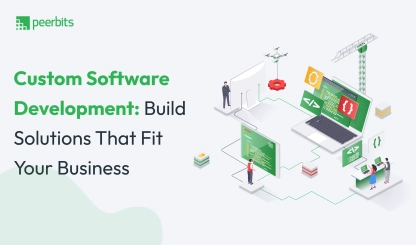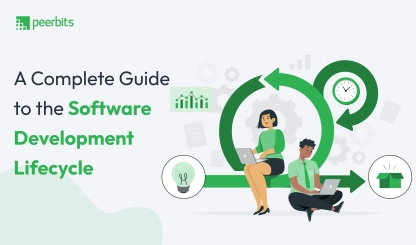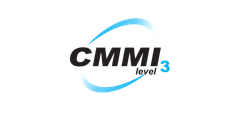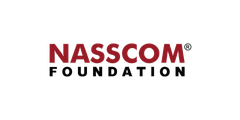SaaS application architecture forms the backbone of modern software delivery, enabling businesses to operate efficiently in today’s environment. In 2025, the SaaS market continues to demonstrate remarkable growth and potential.
According to data from Precedence Research, the global SaaS market size stood at USD 358.33 billion in 2024 and is projected to soar to USD 1,251.35 billion by 2034, driven by a compound annual growth rate (CAGR) of 13.3% from 2024 to 2034.
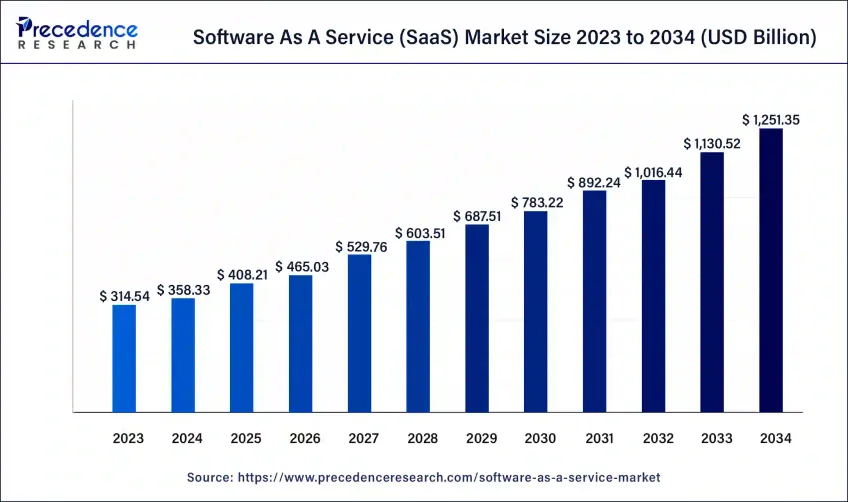
This exponential growth highlights the rising demand for scalable, innovative, and adaptable SaaS application design. As developing technologies of SaaS development companies redefine market expectations, businesses must rethink their SaaS system design to remain competitive and meet evolving user needs.
In this blog, we're getting into the latest trends that are changing the game for SaaS app architecture in 2025. We'll talk about everything from AI and Web3 to making things more eco-friendly and beefing up security.
Get ready to learn how these innovations are carrying the next wave of revolutionary SaaS systems!
Core technologies transforming SaaS
SaaS application architecture is advancing through a range of technologies that are redefining how applications are built and used. These innovations are fostering efficiency and delivering new possibilities across industries.
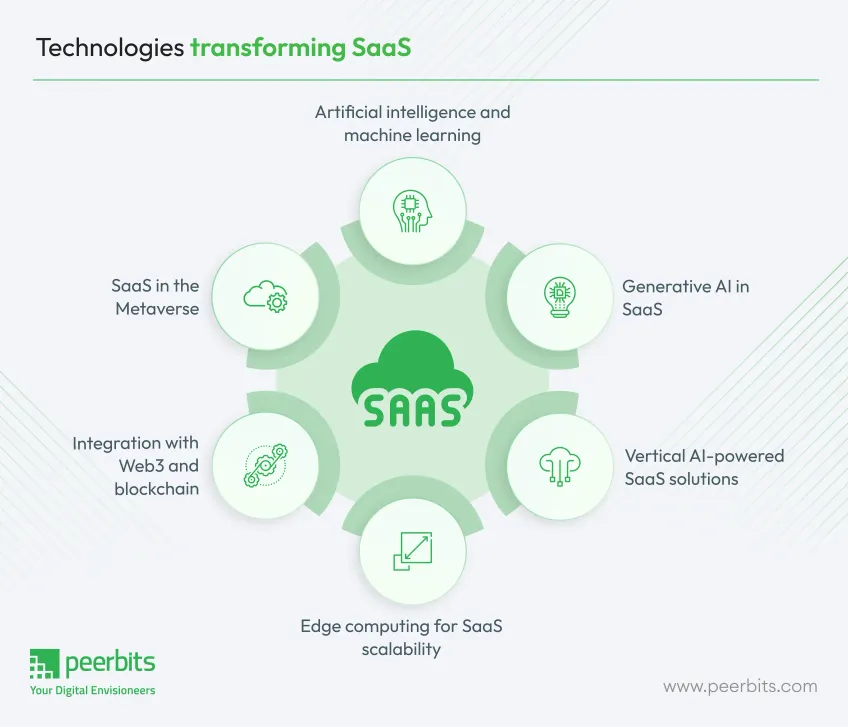
1. Artificial intelligence and machine learning
Artificial intelligence (AI) and machine learning (ML) are central to modern SaaS systems. They automate complex processes, provide actionable insights through advanced data analysis, and support operational improvements.
AI and ML also help businesses offer customized experiences to their customers by analysing user data.
2. Generative AI in SaaS
Generative AI is transforming SaaS application design by creating smarter user interfaces and more engaging user experiences. It accelerates content production with precision and supports customer service through automated yet natural interactions.
These advancements contribute to a more efficient and intuitive application experience.
3. Vertical AI-powered SaaS solutions
AI-powered tools designed for specific industries are becoming increasingly common. Sectors like healthcare, retail, and finance benefit from these solutions.
These solutions address their unique requirements and challenges, providing specialized features that deliver better results.
4. Edge computing for SaaS scalability
Edge computing helps in improving SaaS application performance. By processing data closer to the user, it reduces delays, increases speed, and optimizes data management.
This ensures reliable service delivery, even in environments with limited network resources.
5. Integration with Web3 and blockchain
Web3 and blockchain technologies are making SaaS applications more secure and transparent. Decentralized frameworks authorize secure data sharing and verifiable transactions while minimizing risks associated with centralized storage.
These technologies are critical for creating trust in modern SaaS solutions.
6. SaaS in the Metaverse
SaaS applications are now adapting to virtual environments like the metaverse. These tools help businesses create collaborative workspaces, real-time interactions, and immersive 3D experiences.
This evolution opens new ways to connect with clients and teams in engaging digital settings.
User-focused innovations in SaaS
As SaaS continues to develop, innovations centered around user convenience and accessibility are making the future of application design. These trends prioritize adaptability, functionality, and personalization to meet diverse user needs.
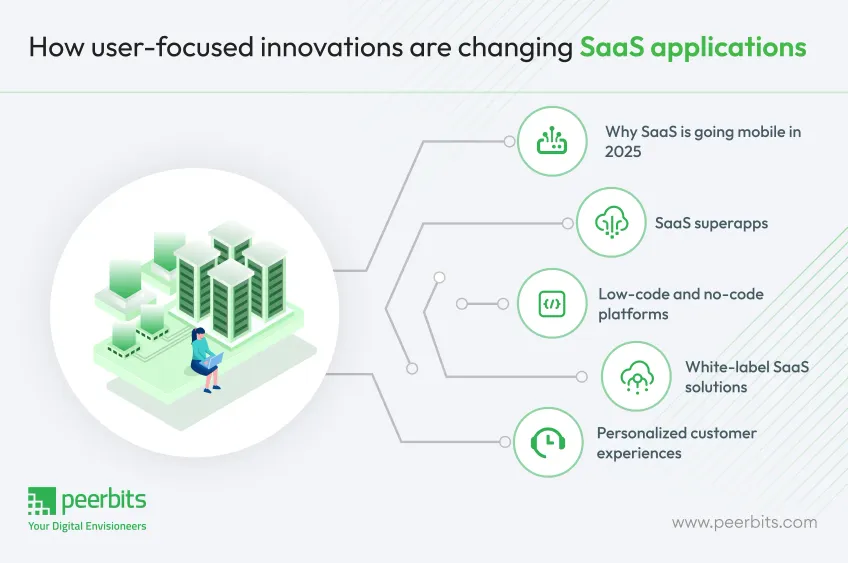
7. Why SaaS is going mobile in 2025
Mobile-first strategies have become a main focus in SaaS application architecture design.
With an increasing number of users depending on mobile devices, SaaS platforms now prioritize responsive user centered designs that deliver smooth functionality across various screen sizes and devices.
8. SaaS superapps
The rise of SaaS superapps reflects a demand for multifunctional platforms that combine diverse services into a single solution. These applications simplify workflows by integrating tools like communication, analytics, and project management.
This offers businesses an all-in-one ecosystem for efficiency.
9. Low-code and no-code platforms
Low-code and no-code helps non-technical users to build and customize applications without extensive coding knowledge. This democratization of development reduces dependency on traditional programming and accelerates project completion times.
Read more: Low-code/No-code DevOps for 10x automation
10. White-label SaaS solutions
Customizable and rebrandable SaaS platforms are gaining traction as businesses seek solutions that stick with their branding and operational needs.
White-label SaaS offerings let companies deploy ready-made software under their branding while focusing on their core goals.
11. Personalized customer experiences
SaaS providers are integrating advanced AI capabilities to deliver highly personalized user experiences.
These applications analyze user behavior and preferences, creating custom interfaces, recommendations, and workflows that improve satisfaction and engagement.

Modern SaaS business models and strategies
SaaS businesses are adopting innovative models and strategies to remain competitive while addressing shifting customer expectations. These strategies focus on maximizing revenue, optimizing growth, and enhancing service delivery.
12. Subscription model evolution
Subscription models are adapting to varied user needs, with usage-based and hybrid pricing structures becoming increasingly popular.
These flexible options cater to businesses of all sizes, letting them pay based on actual consumption or a mix of flat fees and variable charges.
13. Efficient customer acquisition techniques
SaaS companies are focusing on cost-effective methods to attract and retain customers. Strategies like community building, incentivized referral programs, and engaging content marketing campaigns help reduce acquisition costs while encouraging long-term loyalty.
Incorporating data-driven insights into marketing efforts ensures these strategies reach the right audience, maximizing their impact.
14. SaaS market consolidation trends
The SaaS landscape is witnessing a rise in mergers and acquisitions as companies aim to create comprehensive ecosystems. Consolidation lets businesses expand their offerings, improve scalability, and deliver integrated solutions, benefiting both providers and users.
15. Modern performance metrics
Metrics like Annual Recurring Revenue (ARR), churn rate, and customer lifetime value (CLV) are now essential for tracking SaaS success.
These indicators offer insights into growth, customer retention, and overall profitability, helping businesses refine their strategies.
16. Platform-as-a-Service (PaaS) integration
PaaS integration is becoming a key element in SaaS system design. It provides a foundation for building scalable applications and supports ecosystem creation by helping developers in expanding the platform’s functionalities with custom modules and services.
PaaS simplifies application deployment and maintenance and lets SaaS providers focus more on innovation and user experience.
Security and compliance priorities in SaaS
As SaaS platforms expand their reach, addressing security and compliance has become a central focus. Businesses are investing in advanced technologies to safeguard data and ensure regulation, creating more reliable environments for users.
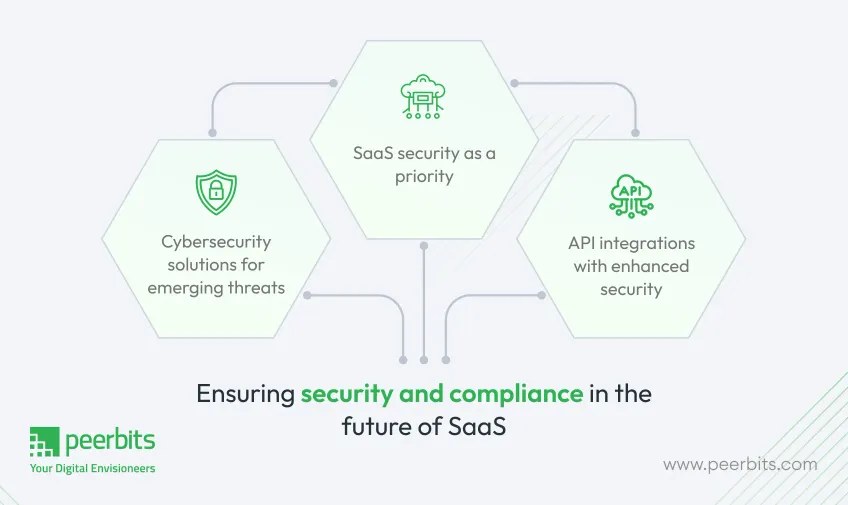
17. Cybersecurity solutions for emerging threats
To counter evolving cyber risks, SaaS platforms are adopting advanced measures such as AI-based threat detection and real-time monitoring systems. These solutions identify and neutralize potential breaches, while modern encryption protocols protect sensitive data during storage and transfer.
Organizations are also integrating predictive analytics to anticipate and mitigate future threats effectively.
18. SaaS security as a priority
Measures like zero-trust architecture enforce strict access controls and let only authorized users interact with the system. Regular security audits and penetration testing further reinforce defenses against potential vulnerabilities.
Adding multi-factor authentication (MFA) provides an additional layer of protection to user accounts.
19. API integrations with enhanced security
APIs are important in SaaS system design as it helps facilitate smooth third-party integrations. Using secure APIs with authentication protocols and encrypted data exchange minimizes risks while helping with smoother interactions between applications.
Adopting API for Saas gateways helps monitor and control API usage, ensuring secure and reliable communication.
Sustainability and environmental impact
Sustainability has become a core consideration for SaaS application architecture design in 2025. Companies are adopting innovative practices to minimize environmental impact while meeting user demands responsibly.
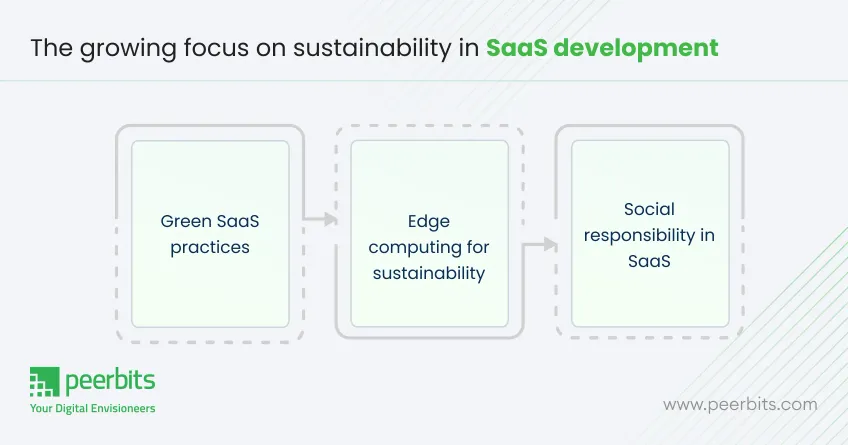
20. Green SaaS practices
SaaS providers are prioritizing eco-conscious initiatives such as optimizing server energy consumption and utilizing renewable energy sources in data centers.
Efforts to reduce carbon footprints also include recycling outdated hardware and adopting sustainable supply chain practices to minimize waste.
21. Edge computing for sustainability
Edge computing supports eco-friendly SaaS by processing data closer to users, reducing the need for energy-intensive centralized data centers.
This strategy minimizes network bandwidth usage and helps lower energy consumption, contributing to sustainability goals.
22. Social responsibility in SaaS
Beyond environmental considerations, SaaS companies are incorporating ethical practices into their operations. This includes implementing AI that sticks with ethical standards and contributing to community-based projects.
Socially responsible initiatives are making a future where technology and society progress together sustainably.
Industry-specific SaaS advancements
SaaS application architecture design is increasingly catering to the specific needs of various industries. These advancements are changing the workflows and improving efficiency in targeted sectors.
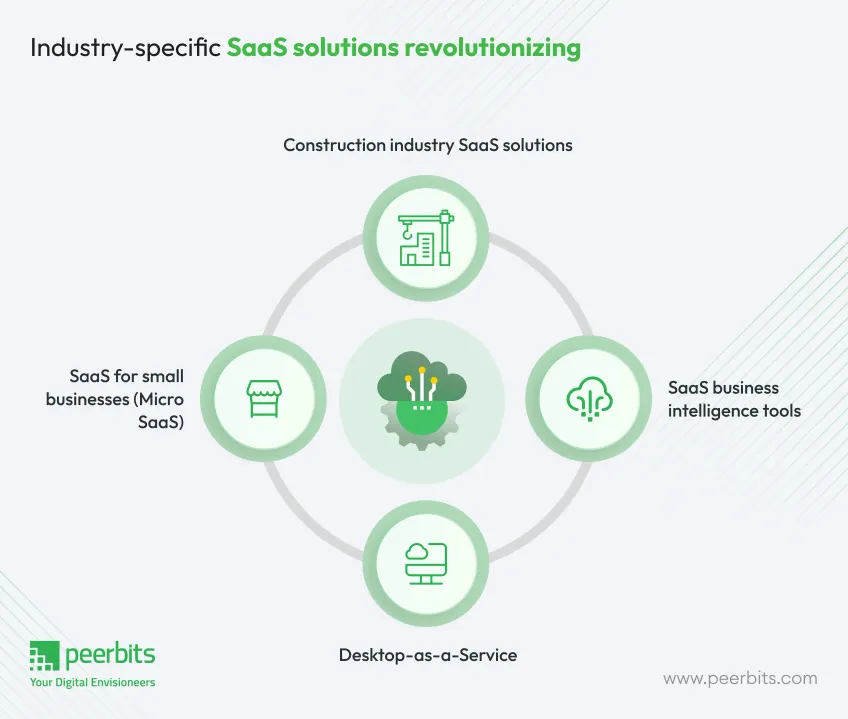
23. Construction industry SaaS solutions
SaaS platforms in construction are offering tools for real-time project tracking, efficient resource allocation, and smooth communication across teams.
Features like drone integration and 3D modeling are further improving project visualization and on-site decision-making.
24. SaaS business intelligence tools
Business intelligence tools powered by SaaS provide organizations with actionable insights through advanced analytics. These tools help industries to utilize big data, track KPIs, and forecast trends for strategic planning, offering a competitive edge.
25. Desktop-as-a-Service
Desktop-as-a-Service helps remote and hybrid work environments by providing virtual desktops accessible from any device. This ensures continuity and security for businesses transitioning to flexible work models.
Scalability and simplified IT management are carrying its widespread adoption.
26. SaaS for small businesses (Micro SaaS)
Micro SaaS solutions are designed to meet the unique needs of startups and small businesses.
With niche functionalities, affordable pricing, and user-friendly interfaces, these platforms are helping smaller enterprises to compete effectively in their markets.
Read more: SaaS Microservices Architecture: Key Considerations for Success
Future-ready innovations in SaaS
As SaaS continues to develop, companies are adopting new innovations to stay ahead of the curve and meet future needs. These advancements are laying the foundation for more intelligent, interconnected, and adaptable SaaS ecosystems.
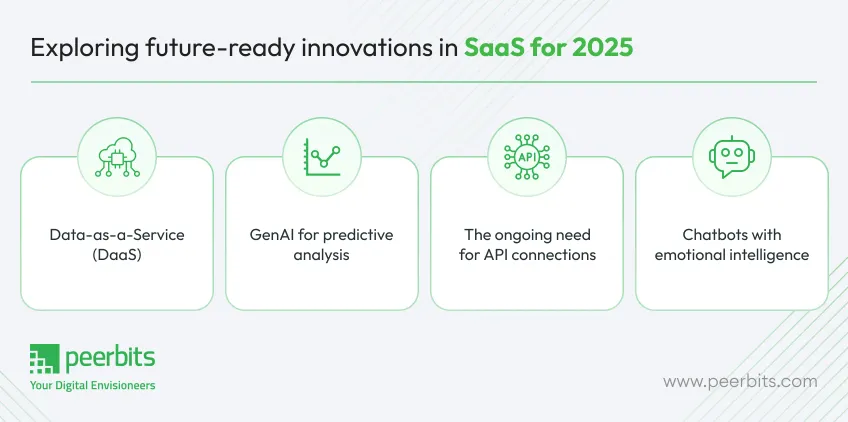
27. Data-as-a-Service (DaaS)
Data-as-a-Service is gaining popularity as businesses seek scalable and flexible data delivery models.
With DaaS, companies can access and analyze real-time data from various sources without managing infrastructure, supporting data-driven decision-making.
28. GenAI for predictive analysis
Generative AI is changing the way of predictive analytics in SaaS platforms. GenAI helps businesses forecast market trends, optimize processes, and make informed decisions by using vast datasets and advanced algorithms.
This helps businesses with improved prediction accuracy.
29. The ongoing need for API connections
The demand for open APIs is growing as businesses focus on improving interoperability between SaaS systems.
APIs support communication between platforms, allowing integrations that expand functionality and improve user experiences across ecosystems.
Read more: API testing methodologies: Advantages and approaches
30. Chatbots with emotional intelligence
Chatbots are becoming more sophisticated with emotional intelligence integration.
These AI chatbots respond empathetically and improve customer service and offer a more human-like digital experience.
Key challenges and opportunities for SaaS in 2025
The growth of SaaS brings with it a mix of challenges and opportunities. Companies must navigate complex fields while capitalizing on emerging possibilities to stay ahead in 2025.
Scalability challenges
- As SaaS platforms expand, maintaining performance under increased user loads can become a critical concern.
- Companies must balance scaling infrastructure, managing operational costs, and ensuring consistent performance to meet user expectations.
Intense competition
- The SaaS market is becoming increasingly crowded, with new players entering various niches.
- This intensifies the need for differentiation through unique offerings, superior customer service, and innovative solutions to stand out from competitors.
User retention struggles
- Retaining customers amidst a sea of alternatives remains a significant challenge.
- SaaS companies must focus on providing exceptional value, intuitive designs, and user experiences to build long-term loyalty.
Opportunities in untapped markets
- Expanding into untapped regions and industries presents significant growth potential.
- Localizing solutions for these markets can open doors to new revenue streams while addressing specific challenges faced by those regions.
Emerging technologies
- The rise of technologies like AI, blockchain, and Web3 offers new possibilities for SaaS innovation.
- Businesses can integrate these advancements to create smarter, more secure, and versatile applications that cater to evolving user needs.
Niche industries
- Targeting niche industries with specialized SaaS solutions is another promising opportunity.
- Companies can carve out a loyal customer base within these focused markets by catering to specific workflows and pain points.
Conclusion
SaaS innovation in 2025 is made by transformative trends such as AI integration, mobile-first strategies, evolving subscription models, and sustainable practices. These advancements are redefining how businesses design and implement SaaS application architecture, creating smarter, faster, and more personalized solutions.
Adopting these trends is essential for staying competitive in the market. SaaS companies can address current challenges while positioning themselves for future opportunities by focusing on scalability.
Looking beyond 2025, the potential of technologies like quantum computing, decentralized data models, and advanced automation points to an exciting future for SaaS. Businesses that stay adaptable and forward-thinking will be well-positioned to shine in this rapidly advancing environment.

FAQs
Single-tenant architecture provides a dedicated software instance for each customer, offering greater control and customization. Multi-tenant architecture serves multiple customers with a shared instance, reducing costs but requiring robust data segregation and security.
SaaS providers typically offer tools and support for seamless data migration, including API-based integrations, data validation processes, and assistance from technical experts to ensure minimal disruption.
Updates and maintenance are typically handled automatically by the provider. Users benefit from new features, security patches, and bug fixes without needing manual intervention, ensuring the application stays up-to-date.
Look for certifications such as ISO/IEC 27001, SOC 2, GDPR compliance, and PCI DSS. These demonstrate adherence to high security and data protection standards.
SaaS providers use strategies like data replication across multiple data centers, frequent backups, and disaster recovery plans to minimize downtime and ensure data restoration in emergencies.

